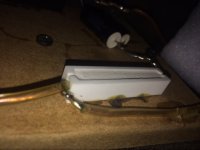Hi all, little puzzle for anyone interested. I have a pair of DIY speakers which I love however they are a little bright (my room is wooden floor wooden walls etc which I can;t change). When the speakers were built the tweeter was an upgrade to the tweeter which was a little brighter than the original in the design so the person who designed the speaker recommended a resistor on the high pass which was added. As it is still a little to bright I am trying to increase the valve of it to make the speaker less bright. However my problem is the resistor (as the pic shows) does not have a value on it! It is 47mm by 10mm by 10mm as best as I can measure so in my very limited knowledge is 10watts and 10ohms - does that sound right??? If so what would I need instead to bring the tweeter down about 1db?? Any help appreciated.
Attachments
Unsolder the side that connects to the capacitor & measure with DVM again just to be sure, a 20 watt resitor will do no harm either & if it still reads 10 ohm then try out a 12.5 ohm resistor. Without having any specs of the tweeter you'd have to slowly increase the resistor value till it sounds right to you.
Cheers
Cheers
It is likely that the resistor value marking may be on the bottom side. It appears that it may be glued there, but you may be able to carefully pry it up and see the markings there.
If that doesn't work, then de-solder and measure as noted in previous post.
If that doesn't work, then de-solder and measure as noted in previous post.
And why I didn't think of that Dave, that's one of the problems when your an old fart. Lol
Getting older myself, so trying to remember things . . .
. . . forgot where I was going with that! 😉
Getting older myself, so trying to remember things . . .
. . . forgot where I was going with that! 😉
Yeah, it really sucks when...um....er....uh....What were we talking about? 🙄
Mike
If it's still a little bright, I think you'll find 1dB isn't enough. I'd go with 3dB, a resistor around 15 ohms.
OK, just quicly tried to see value of resistor but as it's glued onto MDF the MDF came off with it so with the glue and MDF was unable to see the value - However I did use the DVM on it while the resistor was still connected and on the setting of 200ohms it read 01.5 (that does'nt mean much to me but on setting 2000 or 20K I didn't get anything.
If you have a 10 ohm (or similar) resistor laying around, try measuring it to see what reading you get.
I don't unfortunately, I only had a small 1/2w 560ohm which at 20K showed .55 - which is no help i'm sure.
Then your meter isn't suitable for low ohms, so don't try to interpret the readings.
Sounds like the resistor was attached with epoxy instead of hot glue (which can
easily be peeled off). Maybe you can borrow a meter, or just remove the resistor
and take it somewhere that you can measure it. Is there still a RadioShack, etc. around?
They also would have the resistors.
Sounds like the resistor was attached with epoxy instead of hot glue (which can
easily be peeled off). Maybe you can borrow a meter, or just remove the resistor
and take it somewhere that you can measure it. Is there still a RadioShack, etc. around?
They also would have the resistors.
Last edited:
Ah, I tested it while still soldered on - mistake? Sorry. I'm new to most of this.
That won't make any difference, since the capacitor isolates it DC-wise from the rest of the circuit.
Ah, OK. I just tried the resistor on the other speaker - almost same result - 1.4
But you don't know what that means. A meter is not even close to accurate near the low end of its range.
But you don't know what that means. A meter is not even close to accurate near the low end of its range.
Should it not read more like 10 rather than 1.5, thought it would be much higher? I'm happy to get a couple of resistors and try them but obviously need to know more or less what the existing resistor is.
Sorry Rayma, only just saw your post about the meter and low value. Will do as you say and try to find a good meter. Thanks.
Should it not read more like 10 rather than 1.5, thought it would be much higher? I'm happy to get a couple of resistors and try them but obviously need to know more or less what the existing resistor is.
The last digit of the reading really has no meaning at all in your particular meter (which is not intended
to measure low ohm values), so find another way to measure that resistor.
- Home
- Loudspeakers
- Multi-Way
- Resistor size unknown
